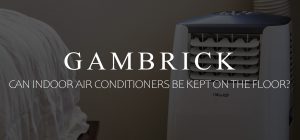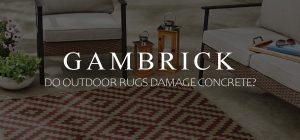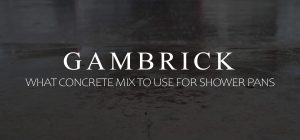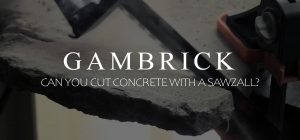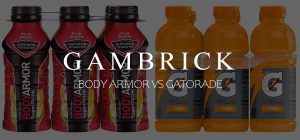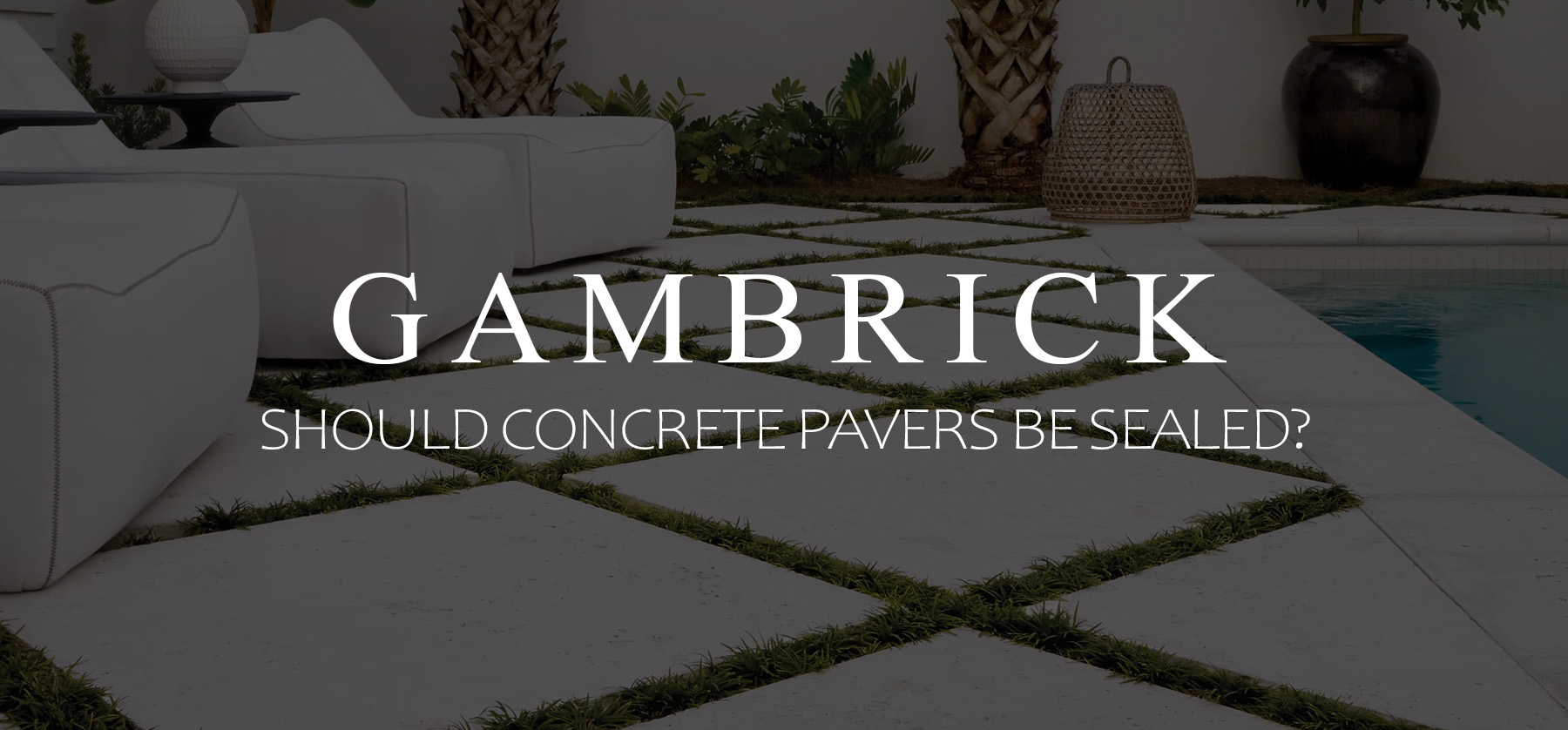
Should Concrete Pavers Be Sealed?
I’ve been a mason for over 25 years and use concrete to build foundations, patios, sidewalks, steps, countertops, driveways, and more. No matter what I build out of concrete, is has one major issue, concrete is very porous, which means it absorbs water like a sponge. Concrete pavers will absorb water into their pores which can lead to all sorts of issues, such as cracks, deterioration, chips, flaking, mold, mildew, fading, etc. Sealing concrete pavers is fairly cheap and easy to do DIY, and prevents all of these issues, if you use the correct type of sealant.
Another benefit to sealing your pavers is slip protection. Some sealants provide extra grip, which helps when they get wet. This is especially important when you’re sealing concrete around a pool.
Sealants work by penetrating into the concrete’s pores and sitting on top of it’s surface. Water, dust, pollen, mold, dirt, etc. can’t penetrate into the paver because it’s stopped by the sealer.
Some sealers also provide some protection against UV sun damage, which prevents colors from fading.
Sealers should be applied with a tough concrete roller and brushes that won’t get chewed up by the concrete’s gritty texture.
Many sealers come with various levels of gloss which can give your patio or border a wet look. This enhances and enriches the color of your pavers.
A sealer offers an additional layer of protection against the elements and the sun.
If maintaining and enhancing the look of your concrete pavers is a priority, then invest in a good sealer. Because if they’re not sealed, pavers won’t look as good or last as long as they should.
Is Sealing Concrete Pavers Necessary?
Sealing pavers isn’t necessary or required. However, it’s highly recommended that you seal exterior concrete surfaces. Especially surfaces that get wet or a lot of sun like flat work. The sealer will preserve and enhance your concrete pavers color as well as protect them from sun and water damage.
Once the concrete pavers have been installed and any grout is in place, most manufacturers recommend waiting about a year before applying sealer. This allows for some efflorescence to escape from the pavers before sealing them.Efflorescence is the white chalky substance that comes out of many brick or masonry products like concrete. It’s basically salts and other minerals working there way out of the paver. When you see it happening just wash it right off with soap and water or use a paver cleaner.
If you seal the paver too soon then you’ll lock in those salts and minerals instead of allowing them to bleed out like they want to. There are some sealers that don’t require a waiting period, so if you don’t want to wait, make sure and buy the right type of sealer.
Some paver warranties require a sealer be applied at a certain point and periodically thereafter. Generally this is required once a year. Make sure to read your warranty if you buy a brand name paver that comes with one. Typically the warranty will cover excessive color fading and paver damage. If this occurs you’ll want to be covered.
Concrete Paver Sealers Prevent Fading
Most people choose concrete pavers over asphalt or regular concrete because of how good they look. Pavers come in a wide variety of shapes, sizes and colors. Over time, concrete pavers can start to fade due to weather conditions and UV sun damage. Better quality pavers fade slower because their color is all the way through. While cheaper pavers fade much faster because the color is only a thin surface layer. But all pavers fade. Sealers can help preserve your pavers coloring by providing an additional layer of protection. Think of a sealer as a sun block or coat of wax on a car for your pavers.
Pavers are very durable all by themselves and very resistant to the elements even when unsealed. However, the coloring used to make the pavers are not as durable as concrete. Over time, they will fade. Using a sealer can help keep the colors bold despite the weathering or sun damage they’ll endure.
Sealing Prevents Stains
A big problem with concrete products is that they absorb water. By nature, concrete is a very porous material that sucks up water like a sponge. That’s true of concrete pavers too. When you mix pavers with outdoor activities involving food and rinks,spill will inevitably happen. It doesn’t matter whether it’s dirt, oil, grease, ketchup, wine or juice, concrete will absorb all of these things and stain.
Grease is a particular problem with concrete pavers. Especially in areas where you have a grill. Any grease that falls on a concrete paver even for just a moment will leave a stain. Even the act of cleaning it up will leave residue behind.
Cleaning a paver isn’t like wiping off a tile floor. When something spills on concrete it gets absorbed into the paver. Simply wiping the substance up won;t get it out of the paver. You’ll have to do some serious scrubbing or use a poultice to draw the stain out.
A good quality sealer will absorb into the pores and create a thin layer over it’s surface. Since the spill can’t penetrate into the concrete pavers pores, it can’t leave a stain behind.
Sealers Enhance Concrete’s Color
Most sealers will enhance a concrete pavers color. When they absorb into the concrete, the sealer makes the color appear a bit darker and bolder. Since most people choose pavers because they want a colorful patio or driveway, enhancing those colors while preserving them is seen as a huge benefit.
Sealers can create a clear, shiny surface on the concrete that most people really like. It gives the pavers a wet look.Gloss can also be added to the sealer in different levels just like a paint. Many people will use a slight shine on the main paver areas with a higher gloss for the trim.
Sealers can also be tinted or include special features like glitter. Using a tinted sealer can play off the colors in your pavers to create a unique look. Glitter can also be added if you want to add a little sparkle to that patio or walkway.
Sealers Increase Grip
Another great feature to using a sealant on your concrete pavers is an increased grip. Many sealers have non slip properties which can be a huge benefit to areas that get wet. Especially around a pool. If you’ve got concrete pavers and are worried about them getting slippery when wet then consider adding a non slip sealer.
Securing The Joints
Most pavers have some sort of aggregate inside the joints. This could be sand, fine gravel or a polymeric product that hardens when wet. These joint fillers are meant to stabilize the pavers and keep them in place. The sand is also helpful for preventing weeds and grass from growing between the pavers.
A sealer will help harden the sand and prevent it from getting dislodged. This will also help prevent weeds, grass, and other plants from growing between the pavers.
Make sure to clean the joints of any debris or weeds growing out of them.
A sealer over the gaps will also help preserve the fill material and keep it stain free. These types of aggregate absorb and hold water and stains even more than concrete does. That’s why the tile in your house can look like new even when the grout is dirty. It’s important to protect the paver and grout lines. If grout gets filthy you’ll have to scrape it out and reapply. That’s a lot of work and more expensive than just sealing the pavers.
Are Some Sealers More Protective Than Others?
There are basically two types of paver sealants: film forming (gloss or semi-gloss finish) and non film forming (matte finish).
- Film forming sealants offer better protection because they create a physical barrier on the paver surface.Offered in wet and gloss finishes.
- Non film forming sealants offer excellent protection too and last a bit longer. A more natural matte look.
Both film forming and non film forming sealers offer great protection. Film forming sealers come in a wet look or with gloss. If that’s the look you want then this is the product for you. However, if you want a more natural matte finish then opt for the non film forming sealers.
In terms of quality, the product you buy definitely matters. There are good quality sealers and there are poor quality sealers. Don’t assume that just because it’s sold in a store that the quality is good. Check reviews before you buy. In general, the more expensive sealers tend to be better and offer additional features like UV resistance, scratch resistance, color guard, additives and non slip finishes.
Downsides To Sealers
The only real downside to using a concrete paver sealer is that they don;t last forever. In general, it’s recommended to reapply the sealer every year or two. It’s not that hard to do and doesn’t cost much, but most people these days want zero maintenance.
The pavers should also be cleaned before applying the sealer.This is another maintenance step that will need to be done every year or so.
Also, some sealers aren’t eco-friendly and can contaminate surrounding trees or plants. If this is a concern for you, but a seal that’s labeled green. They typically don;t last as long but work just as good. Be prepared to reapply a green sealer every 6 months to a year.
Always use a mask, eye protection and gloves while applying a sealer. Sealing concrete isn’t typically considered dangerous but you should always take some general safety precautions. make sure to have good ventilation. And check the safety warning on the sealer your using. Some are more harmful than others.
A sealer doesn’t cost much, especially when compared to repairing or replacing damaged pavers or grout sand. But it’s still an additional cost you’ll have to pay every so often.
Should You Prep The Pavers Before Applying A Sealer?
Even new pavers should be cleaned prior to sealing. Not only will it clean the pavers surface, but it will clean out the paver pores which allows for better sealer penetration.
Any efflorescence that has accumulated should be cleaned off the pavers before you seal them. Stains should also be removed prior to applying a sealer or else you’ll lock them in.
Brush off any dirt, pollen, dust etc. off the pavers. Make sure not to disturb the paver joint aggregate. If there’s sand on the pavers it will be locked in place by the sealer.
How Long Should Pavers Dry Before Sealing?
The pavers should be completely dry before a sealer is applied. This is very important. Make sure not to seal over wet pavers because the moisture will be locked in.
The amount of time you should wait depends on your climate and the weather. In warm, sunny climates, pavers will typically be dry and ready to seal in just a few hours. But in cooler climates or shady areas, it’s best to wait about 24 hours.
What’s The Ideal Weather For Sealing Concrete Pavers?
The ideal weather conditions would be 75 degrees and sunny and not too humid. However, anywhere between 50-90 degrees is generally fine. Watch the humidity though, temperature is only part of the equation. When the air is full of moisture it takes longer for the pavers to dry out.
Take note that solvent based sealants evaporate faster. This means that lower temperatures are actually better.
Don’t apply a sealer when it’s too hot or too cold. This is not only about air temperature but also the surface of your pavers. If you touch the pavers and they’re either very cold or very hot, then wait until conditions improve.
How Often Should A Paver Sealer Be Applied?
The basic rule of thumb is every 3-5 years but some need it in 6 months and others a year. It all depends on the type of sealer your using. The greener the product the faster it needs to be reapplied.
There’s a simple test we use to determine if the sealer is ready to be reapplied. Spray some water on the surface of your pavers. If the water absorbs it’s time to reapply. But if the water beads up and sits on the surface, the sealer is still working.
You may also see some changes in the finish depending on the sealer you used. Some sealers enhance colors and add additional features like glitter, slip resistance or gloss. When these start to fade that means the sealer’s protection is too.
Paver Sealing Application Tips
- It’s best to keep a wet edge on a continuous area. In other words, don’t let a section dry before you finish sealing it. The entire area needs to be finished in one application.
- If for some reason you have to stop sealing in the middle of a job, make sure to stop at the edge of a paver and not in the middle. This will help hide the line where you stopped.
- A sprayer makes work easier and faster however I prefer using a roller.
- Apply paver sealant to full saturation. Get the pavers fully wet to ensure every crevice is covered.
- Use a dry roller to soak up any excess sealer to avoid lines and drip marks. Pooled sealer can create a haze that looks really bad. This coats are best.
- Apply multiple thin coats of sealer in different directions. For example, apply the first coat with a roller moving up and down. The second coat should be left to right. By applying sealant in different directions you make sure to hit every surface.
- Always follow the manufacturer’s instructions.
- When in doubt, hire a professional. Sealing concrete pavers isn’t that hard and makes a great DIY project but it isn’t for everyone.
Summary: Should Concrete Pavers Be Sealed?
I’ve been a mason for over 25 years and use concrete to build foundations, patios, sidewalks, steps, countertops, driveways, and more. No matter what I build out of concrete, is has one major issue, concrete is very porous, which means it absorbs water like a sponge. Concrete pavers will absorb water into their pores which can lead to all sorts of issues, such as cracks, deterioration, chips, flaking, mold, mildew, fading, etc. Sealing concrete pavers is fairly cheap and easy to do DIY, and prevents all of these issues, if you use the correct type of sealant.
Another benefit to sealing your pavers is slip protection. Some sealants provide extra grip, which helps when they get wet. This is especially important when you’re sealing concrete around a pool.
Sealants work by penetrating into the concrete’s pores and sitting on top of it’s surface. Water, dust, pollen, mold, dirt, etc. can’t penetrate into the paver because it’s stopped by the sealer.
Some sealers also provide some protection against UV sun damage, which prevents colors from fading.
Sealers should be applied with a tough concrete roller and brushes that won’t get chewed up by the concrete’s gritty texture.
Many sealers come with various levels of gloss which can give your patio or border a wet look. This enhances and enriches the color of your pavers.
A sealer offers an additional layer of protection against the elements and the sun.
If maintaining and enhancing the look of your concrete pavers is a priority, then invest in a good sealer. Because if they’re not sealed, pavers won’t look as good or last as long as they should.
If you have any questions or comments e-mail us any time. We’d love to hear from you.

John Mazzuca | About | More Posts |
Custom Home Builder
John Mazzuca is a custom home designer and builder at Gambrick with over 25 years experience in the construction industry. John has designed, built and/or remodeled hundreds of homes, small buildings, and commercial projects. He writes about business, real estate, home building, and household electronics. His work has been featured in Fox Business, Better Homes & Garden, House Beautiful, and more.






